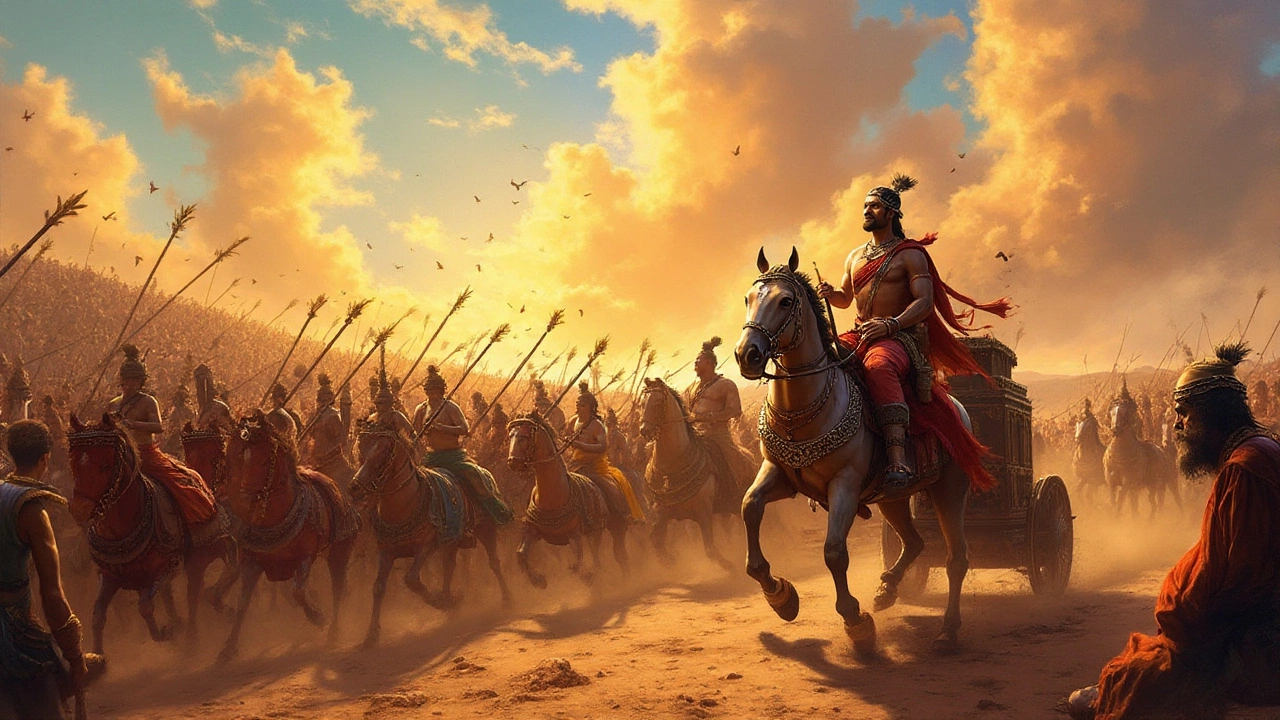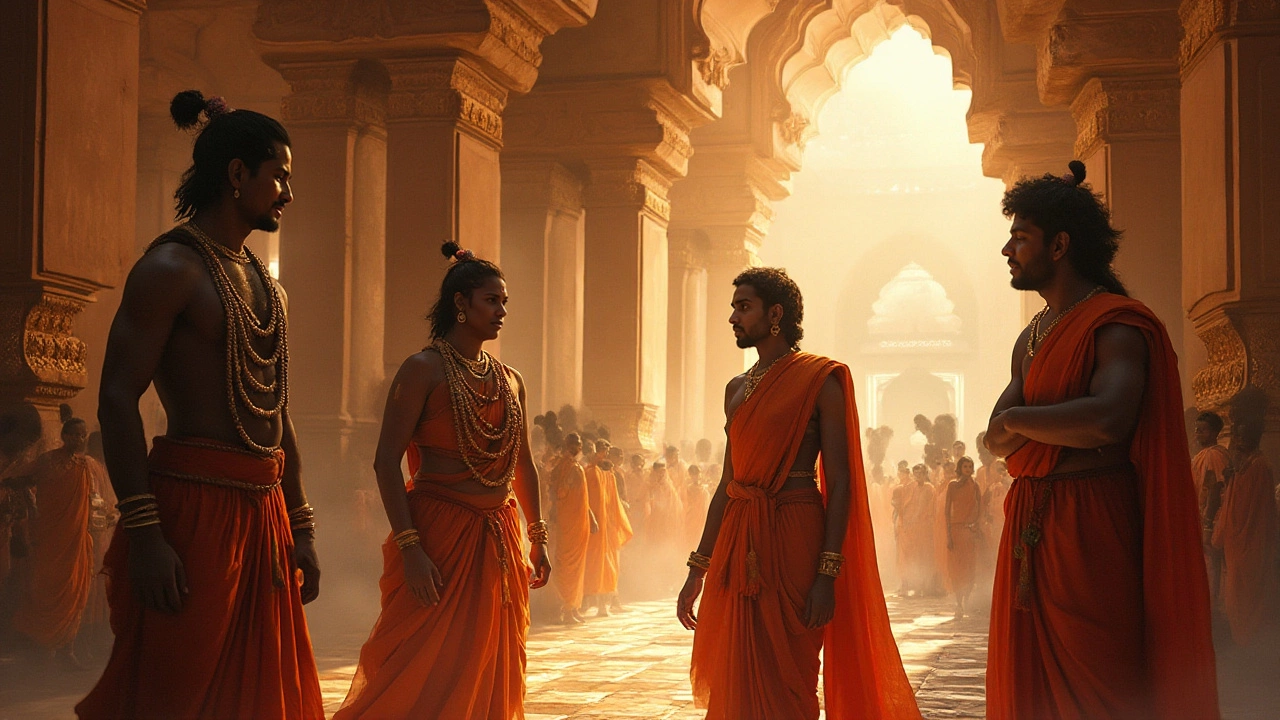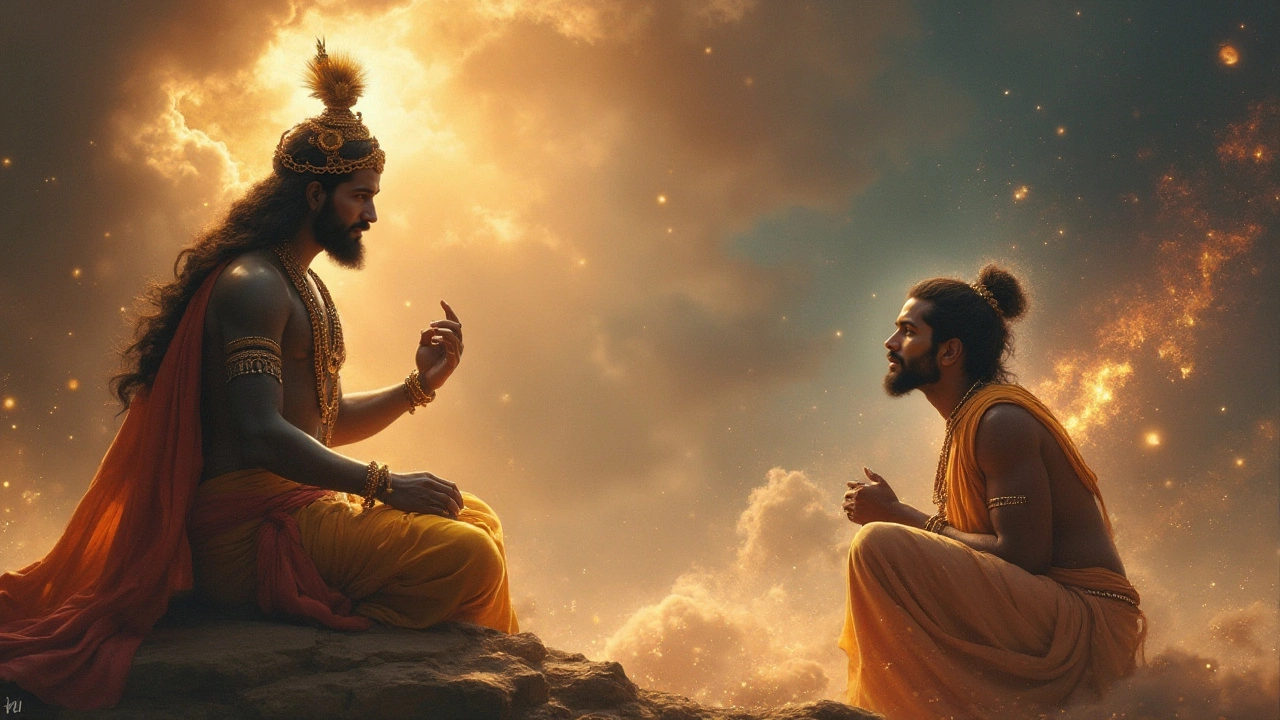
India's rich literary heritage is adorned with monumental works that have shaped the cultural and philosophical contours of the nation. Amid these towering creations stands the Mahabharata, claiming its place as the largest epic ever written. This Sanskrit epic, composed by the sage Vyasa, delves into the complexities of human nature, explores the realms of duty and righteousness, and offers a narrative world teeming with vivid characters and profound teachings.
But this epic is more than just a tale of dynastic conflict and cosmic endeavors. It is a profound reflection on life itself, filled with age-old wisdom that continues to inspire and challenge readers around the world. Within its verses lie the stories of gods and kings, warriors and sages, each contributing to the grand tapestry that makes the Mahabharata an unparalleled literary masterpiece.
- Introduction to the Mahabharata
- Historical Context and Composition
- Key Themes and Narratives
- Cultural and Religious Impact
- Lesser-known Facts and Trivia
Introduction to the Mahabharata
The Mahabharata is not just an epic; it is a sprawling narrative that captures the essence of ancient Indian civilization. With over 100,000 couplets, it stands as the world's longest poem, seven times the length of the Iliad and Odyssey combined. Attributed to the sage Veda Vyasa, its compilation spans centuries, growing through an oral tradition before being inscribed in the form we recognize today. The epic's timeline is ambitious, stretching across mythological ages while chronicling the diverse facets of life, duty, power, and morality. It is set around the Kurukshetra War, an 18-day battle that decides the fate of the Pandavas and Kauravas, members of the same family vying for control over a kingdom. But within this conflict lies a myriad of stories, each with its own set of characters, themes, and lessons.
The Mahabharata's influence is pervasive, deeply rooted in Indian culture and consciousness. Beyond the primary story arc, the text raises profound questions about human existence through philosophical discourses like the Bhagavad Gita, where Lord Krishna imparts wisdom to Prince Arjuna on the battlefield. This interaction transcends the narrative, providing guidance that resonates with countless individuals seeking clarity in moral complexities. The epic also delves into stories of love, betrayal, duty, and sacrifice, painting a nuanced picture of human relationships and the eternal struggle between good and evil. "The Mahabharata, in seeking to be more than itself, succeeds in becoming immortal," noted the renowned Indologist, John D. Smith.
Structurally, the Mahabharata is divided into 18 parvas or books, each serving a unique purpose and highlighting different aspects of the tale. Its narrative style is rich and multifaceted, employing various genres like prose, poetry, and didactic discourse. Through its layered storytelling, it offers both entertainment and enlightenment, challenging readers to reflect on their values and beliefs. The epic's longevity is a testament to its relevance, echoing timeless themes and insights that continue to inspire countless adaptations in theatre, film, and literature. Indeed, the Mahabharata holds a mirror to human nature, revealing the timeless dilemmas that define the human experience.
The impact of the Mahabharata extends far beyond literature, influencing various fields such as art, politics, and religion. It has been a touchstone for scholars, politicians, and philosophers who draw from its depth of wisdom. Integral to Hindu traditions and beliefs, the epic straddles the line between myth and reality, presenting stories that are as much about the divine as they are about humanity. This blend is skillfully woven into the cultural fabric of India, making the Mahabharata an indispensable part of its heritage and identity, showing the world the profound storytelling legacy that India has to offer.
Historical Context and Composition
The genesis of the Mahabharata is a fascinating tapestry woven with the threads of history, mythology, and oral tradition. Often attributed to the legendary sage Vyasa, this epic's origins are steeped in mystery and grandeur. It is said to have been composed over centuries, between the 8th and 9th centuries BCE, taking a sprawling form that reflects the myriad phases of ancient Indian society. Symbolizing the shift from Vedic to post-Vedic ritualistic society, the Mahabharata captures the essence of an era rich in transition and transformation.
The complexity of the Mahabharata lies in its dual role as both a historical account and a reflection of cultural mythology. Its detailed portrayal of the Kurukshetra War acts as an anchor in the expansive narrative, where familial betrayal, divine intervention, and the struggle for ethical leadership demand the reader's attention. Comprising an astounding 100,000 shlokas, it is this very enormity that testifies to the epic's virtuosity, presenting an extensive array of characters, dialogues, philosophies, and myths, each contributing to the epic's descriptive magnificence.
The composition of the Mahabharata is meticulous, structured into eighteen parvas or books, each with its unique narrative journey. The varied themes within these parvas, ranging from political intrigue and philosophical discourse to spiritual concepts and ethical teachings, embody the rich spectrum of human experience. This structural diversity allows the epic to explore topics as vast as the cosmos itself, with the Bhagavad Gita, an integral part of the Mahabharata, delving into profound spiritual discourse. According to the scholar Wendy Doniger, the epic asks "the big questions, grapples with the no-solution dilemmas of being alive, treats mythology seriously, and imagination as though fiction and history were one."
Sanskrit literature reveres the Mahabharata not just as a religious scripture but as an encyclopedic compilation of human knowledge and philosophy. As the story unfolded, passed down through oral traditions before its transcription, it bore witness to the collective memory of generations, reflecting societal changes and evolving moral perspectives. The tale's conclusions have commanded debate, interpretation, and teachings, translating into countless renditions across languages and genres. Its fluid narrative continues to inspire artistic expressions, be it in the form of dramatic plays or modern cinematic adaptations, shaping the moral and ethical framework of societies beyond its Indian roots.
The influence of the Mahabharata is irrefutable, as it extends far beyond the boundaries of ancient India. Its versions have found homes in various cultures across Southeast Asia, with adaptations seen in Indonesian, Thai, and Cambodian literature, each carrying its unique cultural imprints. This universal appeal exemplifies the epic's adaptability and enduring significance. The legacy of the Mahabharata is not simply in its sheer scale or narrative complexity, but in its timeless exploration of humanity, compelling us to reflect on our values, decisions, and the intricate dance of fate and free will.

Key Themes and Narratives
The Mahabharata stands as a colossal tapestry weaving countless stories into a single, complex narrative. At its core, the epic revolves around the Kurukshetra War, an emblematic battle between the Pandavas and the Kauravas. Yet, underneath this martial grandeur lies an exploration of deep philosophical quandaries and moral dilemmas that continue to resonate through ages. One of the central themes is 'Dharma', the principle of cosmic order, which is intricately dissected through the actions and choices of its characters. The struggle to adhere to one's duty, even when the path is fraught with uncertainty and pain, forms the crux of this epic tale.
Another profound theme is the concept of fate versus free will. The characters in the Mahabharata are often positioned at the crossroads where their actions determine their destinies. Through their stories, this Indian epic raises questions about the extent of an individual's control over their destiny amid the divine will. The interplay of fate and agency is beautifully illustrated in the unique story arcs of Karna, who grapples with betrayal and loyalty, and Arjuna, whose crisis at the battlefield's onset leads to the timeless dialogue of the Bhagavad Gita.
The narrative is equally rich with the theme of family allegiance and conflict. The Mahabharata introduces an ever-complicated web of interpersonal relationships and ethical conundrums that shape the destinies of its numerous protagonists. Loyalty, betrayal, love, and envy entwine through the storyline, painting a realistic portrayal of family dynamics. Alongside, the idea of illusion and reality emerges as a critical reflection, challenging characters, and readers to perceive beyond appearances. This philosophical nudge is vividly captured when Yudhishthira, the eldest Pandava, faces tests in the Yaksha Prashna episode.
Within the voluminous text, one finds episodes that convey timeless wisdom. For instance, the Bhagavad Gita, often referred to as a standalone spiritual and philosophical masterpiece, is nestled within the narrative, offering profound insights. Its dialogue between Lord Krishna and Arjuna touches on themes of duty, righteousness, and the nature of existence, encapsulating the essence of the epic's spiritual discourse. As one delves deeper into this epic, an intricate web of sub-narratives emerges, each contributing layers to the overarching storyline.
The Mahabharata holds myriad doorways to understanding life’s fundamental questions. As Eknath Easwaran once said, 'To read the Mahabharata is not to be better informed, but to be more awake.'
Thus, through its enduring characters and their vivid journeys, the Mahabharata paints a portrait of life that transcends time and geography. Its legacy offers lessons about governance, leadership, ethics, and spirituality, aspects that continue to influence contemporary Indian culture and society. The epic, with its intricate theme patterns and rich narratives, remains a profound source of reflection and learning, inviting each generation to delve into its verses and draw meanings anew.
Cultural and Religious Impact
The Mahabharata holds a distinctive place in the cultural and religious scaffold of India, rendering its influence far beyond mere storytelling. It permeates the very essence of daily life, art, and religious practice. This epic, with its sprawling narrative and myriad characters, embodies a universe of experiences and teachings that continue to resonate across generations. Its tales are not confined to the past but continue to inspire performances in traditional art forms such as dance and theatre, with renditions that bring its complex stories to life. The epic’s influence extends to television and cinema, which have endeavored to interpret and bring its stories to modern audiences, revealing its timeless appeal in every era.
This epic poem explores profound philosophical questioning, offering insights through dialogues like the ones found in the Bhagavad Gita, a sacred text cherished within Hinduism. Here, the discourse between Lord Krishna and Prince Arjuna during the Kurukshetra war provides critical reflections on duty, morality, and life’s ultimate purpose. Such teachings have formed the cornerstone of Indian philosophical and spiritual thought, impacting religious practices and personal worldviews. An interesting dimension is how it encapsulates the concept of Dharma or righteous path, as a living question rather than an absolute answer. This dynamic allows the epic to guide individuals through moral complexities, heightening its religious significance.
The Ripple Effect of Tradition
The social rituals and traditions depicted in the Mahabharata often reflect longstanding societal practices that are visible even today. The festival of Golu, particularly in South India, showcases scenes from the epic in the form of beautifully arranged idols, reflecting how these cultural threads weave through regional practices. In more contemporary illustration, television productions, starting with the highly successful 1988 series, have become cultural landmarks themselves, drawing millions to small screens to collectively witness the grandeur of the epic's retelling.
"The Mahabharata is not just a book, it is an entire culture to be explored." – William Dalrymple, historian and author
The Mahabharata's pervasive impact is also visible in Indian literature where its reflection can be found in countless interpretations and allusions. Authors from Rabindranath Tagore to Kamala Das have drawn upon its themes, using them as a canvas to explore social paradigms and personal introspections. The all-encompassing nature of this epic allows it to adapt, providing layers of meaning that can be interpreted anew in different contexts, making it an inexhaustible source of cultural dialogue.
As an epic that bridges the past with the present, the Mahabharata’s influence does not diminish; rather, it evolves, continuously shaping the cultural and religious contours of Indian life. Its teachings on duty, humanity, and the eternal struggle for righteousness remain deeply ingrained in the psyche of India, exerting an undeniable impact on both personal faith and collective culture.

Lesser-known Facts and Trivia
The Mahabharata is much more than a simple epic tale; it possesses a wealth of lesser-known facts and peculiarities that often intrigue scholars and enthusiasts alike. One such riveting detail is the sheer enormity of its size. Comprising over 100,000 couplets, or 200,000 individual verse lines, the Mahabharata is roughly eight times the length of the Odyssey and the Iliad combined. This staggering volume makes it the longest epic poem in the world, and remarkably, it continues to expand in various regional adaptations.
Another captivating aspect concerns its composition. Traditionally, it is believed that the sage Vyasa dictated the epic to Lord Ganesha, who served as the scribe. According to the tale, Ganesha agreed to write only if Vyasa could maintain an uninterrupted flow of verses. This unique collaboration adds a divine touch to the narrative's genesis, emphasizing the intersection of myth and history that threads through the epic. Interestingly, the Mahabharata wasn't written down until centuries after its supposed composition, relying on oral transmission to preserve its stories through generations.
The Mahabharata also houses within its vast narrative one of the most revered spiritual texts in Hinduism, the Bhagavad Gita. This celebrated dialogue between Prince Arjuna and Lord Krishna occurs on the battlefield of Kurukshetra, encapsulating profound philosophical discourse on life, duty, and the pursuit of truth. With themes ranging from existential dilemmas to the exploration of dharma, or righteous duty, the Gita's inclusion intensifies the Mahabharata's significance and underscores its enduring impact on Indian culture and beyond.
"The Mahabharata is not just another heroic epic; it is the 'itihasa', a real narrative, meaningful in its time, and continues to be relevant as we re-negotiate our relationship with our ancient past,” says historian Romila Thapar.
Beyond its core narrative, the Mahabharata encompasses numerous subplots that traverse a rich tapestry of subjects such as ethics, metaphysics, and devotion. It contains engaged discussions on contemporary political theory within a mythical context, an aspect often overshadowed by its more popularly recognized narratives. The Udyoga Parva and Shanti Parva intricately delve into the concepts of statecraft, governance, and the ideal characteristics of a ruler, providing passages laden with insights into ancient geopolitical wisdom.
As it would seem, the epic also transcends criteria even with its adaptation into regional languages and cultures, giving rise to diverse versions that reflect local traditions and storytelling styles. From the Tamil adaptation, entitled Punarvasu's rendering, to the vernacular Javanese and Balinese versions, the Mahabharata has found expression in various forms across Southeast Asia. These adaptations affirm its universal appeal and continual relevance. It is this aspect of cultural fluidity, where tales echo across borders, that contributes to making the Mahabharata not merely a poem but a living, breathing phenomenon in the literary landscape.